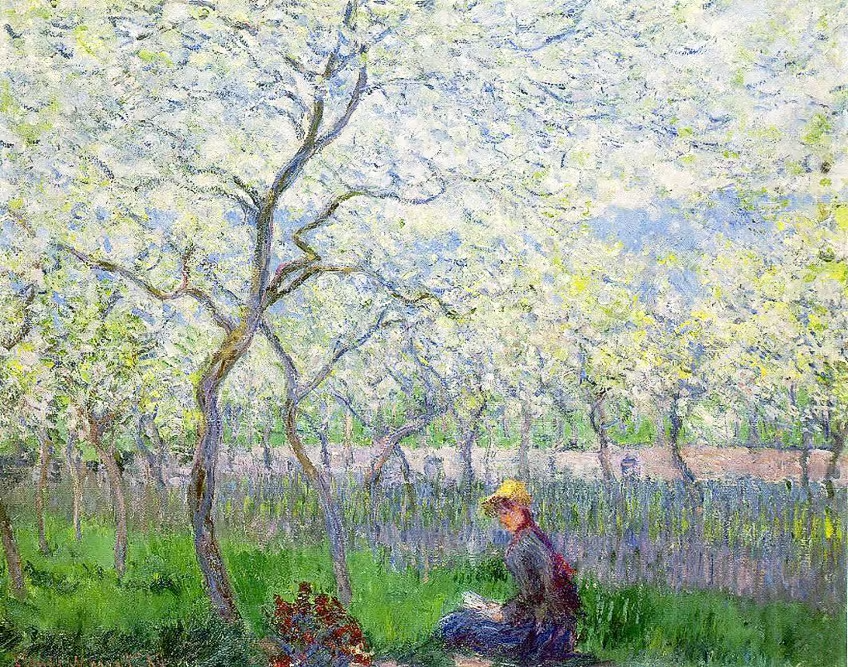Spring is a fierce reminder that from the barren comes the bloom, challenging the gloom to surrender to life.
This eternal cycle of rebirth and renewal is captured in the world's most beautiful spring paintings, each a tribute to nature's resilience and beauty. 🧵⤵️
This eternal cycle of rebirth and renewal is captured in the world's most beautiful spring paintings, each a tribute to nature's resilience and beauty. 🧵⤵️

1. "Primavera" by Sandro Botticelli - A Renaissance masterpiece filled with mythological symbolism and lush, spring imagery. 

2. "Almond Blossom" by Vincent van Gogh - This painting is a celebration of spring and new life, with vibrant blue skies and blossoming almond trees. 

3. "Spring" by Pieter Brueghel the Younger (1635) - A 17th-century village awakens in spring, blending Flemish detail with the season's joy in bustling human and natural life. 

4. "The Orchard" by Claude Monet - An impressionist depiction of a spring orchard in bloom, showcasing Monet's mastery of light and color. 

5. "Spring" by Nicolas Poussin (1664) - Poussin's classical depiction of spring harmonizes mythological elegance with the season's renewal, capturing timeless beauty in serene landscapes. 

6. "A Spring Morning in the Heart of the City" by Childe Hassam - An American Impressionist painting capturing the lively essence of spring in an urban setting. 

7. "Spring in Italy" by Isaac Levitan (1890) - A serene depiction of the Italian countryside, highlighting the tranquil beauty of spring. 

8. "Plum Trees in Blossom Éragny" (1894) by Camille Pissarro - A vibrant and lively representation of plum trees in spring, showcasing the beauty of nature's renewal. 

9. "Springtime" by Pierre-Auguste Cot - A romantic and idealized portrayal of young love in a lush spring setting. 

10. "Vasanti Ragini, Page from a Ragamala Series" (1710), India - This exquisite piece from the Ragamala series embodies the spirit of spring through vibrant colors and poetic imagery, intertwining music, mood, and season in a celebration of cultural heritage. 

11. "Kumoi-Zakura" by Hiroshi Yoshida (1920) - Yoshida's print captures the ephemeral beauty of cherry blossoms against a serene sky, embodying the fleeting essence of spring in Japan with delicate precision and tranquil harmony. 

12. "Wisteria" by Claude Monet - Part of Monet's exploration of his Giverny garden, this painting immerses the viewer in the beauty and tranquility of blooming wisteria. 

13. "The Swing" by Jean-Honoré Fragonard (1767) - Fragonard's iconic work, with its playful romance and lush, verdant setting, encapsulates the frivolity and sensuousness of spring, immortalized in the rococo style's exuberant embrace of color and light 

14. "The Storm" by Pierre-Auguste Cot - Cot's masterpiece, with its dramatic portrayal of young lovers caught in a sudden spring storm, combines the intensity of emotion with the transient beauty of nature, capturing a moment of both vulnerability and enchantment. ![By Pierre Auguste Cot - 1. Pierre-Auguste Cot: The Storm (87.15.134). In Timeline of Art History. New York: The Metropolitan Museum of Art, 2000–. [1] (January 2007)2. Metropolitan Museum of Art, online collection (The Met object ID 435997), Public Domain, https://commons.wikimedia.org/w/index.php?curid=1601165](/images/1px.png)
![By Pierre Auguste Cot - 1. Pierre-Auguste Cot: The Storm (87.15.134). In Timeline of Art History. New York: The Metropolitan Museum of Art, 2000–. [1] (January 2007)2. Metropolitan Museum of Art, online collection (The Met object ID 435997), Public Domain, https://commons.wikimedia.org/w/index.php?curid=1601165](https://pbs.twimg.com/media/GHgdUv5XEAAd0cH.jpg)
15. "The Mount Riboudet in Rouen" at Spring by Claude Monet (1872) - Monet's impressionistic view of Rouen in spring captures the luminous play of light and shadow, showcasing his masterful depiction of the season's vibrant colors and atmospheric changes. 

As spring reawakens the earth, which masterpieces of its renewal should be included in our collection? 

• • •
Missing some Tweet in this thread? You can try to
force a refresh





















